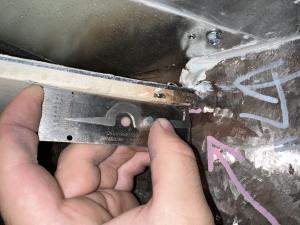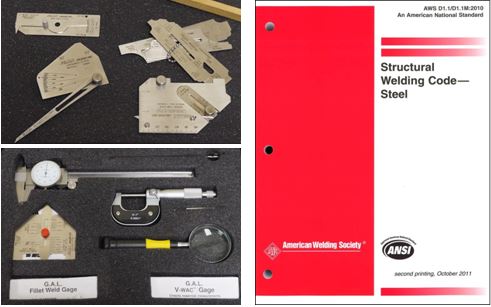A Comprehensive Overview to Welding Evaluation: Understanding Criteria, Techniques, and Ideal Practices for Quality Assurance
Welding inspection plays a pivotal duty in making sure the architectural stability and safety of bonded parts, necessitating a complete understanding of market criteria such as those established by AWS and ASME. Numerous examination methods, consisting of visual and ultrasonic screening, are used to spot prospective flaws that might jeopardize top quality. Carrying out ideal practices can significantly enhance functional reliability and foster depend on amongst clients. As we explore these crucial aspects, it becomes apparent that the effects of welding inspection prolong much beyond compliance, welcoming a closer assessment of exactly how these processes shape sector standards and techniques.
Value of Welding Evaluation
Welding evaluation plays an essential role in making sure the honesty and security of welded structures. It is a necessary procedure that validates that welds satisfy predefined specs, which is important in various industries, including building, automotive, and aerospace. By conducting extensive evaluations, prospective defects such as cracks, insufficient blend, and porosity can be recognized early, preventing tragic failings that can result in mishaps or pricey fixings.
The importance of welding examination expands past simple conformity with regulations; it also cultivates count on with stakeholders. Clients and regulatory bodies anticipate assurance that the frameworks they depend on are built to hold up against operational tensions. Efficient welding assessment methods contribute to lasting durability and performance of the frameworks, inevitably leading to lowered maintenance expenses.
Additionally, welding inspection promotes a society of top quality within organizations, urging adherence to finest methods and continuous enhancement. By integrating inspection procedures right into the welding workflow, companies can enhance their track record and establish themselves as leaders in quality control. To conclude, the relevance of welding evaluation exists in its capability to protect lives, guarantee structural integrity, and copyright market standards, making it an indispensable element of welding procedures.
Secret Sector Criteria
Ensuring compliance with essential market standards is crucial for preserving the quality and safety and security of bonded frameworks. Various companies develop these standards to promote ideal practices in welding and evaluation - Welding Inspection Gilbert Arizona. Among the most acknowledged are the American Welding Society (AWS) and the American Society of Mechanical Engineers (ASME), which provide detailed standards and specifications for welding processes and assessment standards
AWS standards, such as AWS D1.1 for architectural welding, synopsis needs for materials, style, and screening to make sure the stability of welds. Similarly, ASME codes, including ASME Section IX, control the credentials of welders and welding treatments, making sure regular quality in industrial applications. Internationally, the ISO 3834 basic emphasizes high quality requirements for combination welding, providing a framework for companies to demonstrate conformity with worldwide ideal practices.
Conformity with these requirements not only improves the dependability of bonded structures however additionally reduces dangers connected with architectural failures. Moreover, adherence to sector standards is commonly a requirement for regulative authorizations and can considerably affect task specs. Eventually, understanding and applying these vital standards are vital for reliable welding assessment and quality guarantee.
Evaluation Techniques Introduction
Effective welding evaluation counts on a selection of techniques made to assess the high quality and integrity of welds. These methods can be extensively classified right into non-destructive and damaging testing (NDT) methods. Non-destructive testing techniques, which are widely preferred in the market, allow for the examination of welds without endangering the honesty of the material.

Among the most frequently used NDT strategies are aesthetic evaluation, ultrasonic screening, radiographic testing, and magnetic bit screening. Visual assessment is commonly the initial action in the examination process, allowing assessors to determine surface area imperfections and analyze weld bead accounts.
Each strategy has its own benefits and constraints, making it important for inspectors to select one of the most suitable method based upon the certain requirements of the task, the materials included, and the criticality of the welds being checked. This careful option upholds and makes certain comprehensive evaluations safety and security and high quality standards in welding operations.
Typical Problems and Their Ramifications
A detailed understanding of common defects in welds is essential for maintaining structural stability and safety in welded building and constructions. Welding flaws can substantially endanger the mechanical homes of the joint, causing failings that can endanger both workers and equipment.
Usual issues consist of porosity, which shows up as tiny gas pockets trapped in the weld steel, damaging the overall structure. Splitting is an additional common problem, usually resulting from fast cooling or improper joint design, bring about anxiety focus that can lead to tragic failures. Insufficient combination takes place when the weld metal falls short to correctly bond with the base product, creating powerlessness that might cause splitting up under tons.
Various other significant problems include damaging, where the weld bead erodes the base steel, and slag additions, which can prevent the weld's stamina. Each of these defects has particular ramifications; for circumstances, porosity can decrease ductility, while splitting straight affects tensile strength. Recognizing and recognizing these flaws during inspection is necessary for guaranteeing and carrying out rehabilitative procedures conformity with sector criteria, inevitably protecting the structural stability of bonded assemblies.
Best Practices for Quality Control
Applying ideal techniques for quality assurance in welding processes is vital for accomplishing ideal outcomes and minimizing defects. One vital practice is the establishment of clear welding treatments that stick to market criteria and requirements. These procedures should consist of in-depth directions pertaining to product choice, joint prep work, and welding techniques to guarantee uniformity and top quality.
Normal training and accreditation of welding employees are also essential. Knowledgeable welders that recognize the value of quality control are extra likely to generate audio welds. Additionally, carrying out a durable evaluation program, consisting of both visual and non-destructive Home Page screening (NDT), can assist determine issues early while doing so, enabling for timely restorative actions.

Finally, promoting a society of quality within the organization urges workers to focus on quality in their work. By sticking to these best techniques, organizations can enhance the integrity of their welding processes, eventually resulting in improved item top quality and reduced prices related to rework and fixings.

Verdict
To conclude, welding assessment plays a vital function in making sure the stability and safety and security of bonded frameworks. Adherence to crucial market requirements, such as those established by AWS and ASME, is essential for reliable quality control. Employing different examination techniques permits the recognition of usual defects, thereby reducing prospective dangers. By implementing best practices, organizations can enhance dependability, minimize maintenance costs, and cultivate depend on amongst customers, inevitably adding to effective welding operations - Welding Inspection Gilbert Arizona.
Additionally, welding assessment advertises a society of high quality within companies, urging adherence to ideal techniques and continuous renovation. In verdict, the relevance of navigate to this site welding inspection lies in its capacity to guard lives, make certain architectural dependability, and maintain industry requirements, making it an indispensable facet of welding procedures.
Amongst the most acknowledged are the American Welding Culture (AWS) and the American Culture of Mechanical Engineers (ASME), which offer comprehensive standards and specifications for welding procedures and assessment requirements.
Eventually, understanding and applying these crucial criteria are crucial for effective welding assessment and top quality assurance.
Reliable welding examination depends on a selection of strategies designed to examine the top quality and integrity of welds.